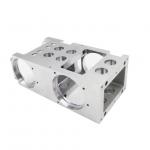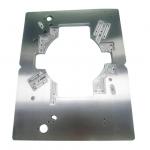Medical device CNC machining is a critical process in the
healthcare industry, enabling the production of high-precision
components essential for medical devices and equipment. By
combining CNC milling and turning, manufacturers can create
complex, reliable, and biocompatible parts that meet the stringent
requirements of the medical sector. This article explores the
significance of medical device CNC machining, CNC milling and
turning, and CNC milling parts, highlighting their applications and
role in advancing healthcare technology.
name | custom manufacturing milling turning aluminum parts cnc machining
service | Materials | Aluminum, copper, brass, stainless steel, steel, iron, alloy, zinc
etc.
Other Special Materials:Lucite/Nylon/titanium/etc | Surface Treatment | Anodizing,Brushing,Galvanized,laser engraving, Silk
printing,polishing,Powder coating,etcSurface Treatment | Tolerance | +/-0.01mm, 100% QC quality inspection before delivery, can provide
quality inspection form | Testing equipment | CMM;Tool microscope;multi-joint arm;Automatic height gauge;Manual
height gauge;Dial gauge;Marble platform;Roughness measurement | Processing | CNC turning, CNC milling, CNC machining, Grinding, EDM wire cutting | File Formats | Solid Works,Pro/Engineer, AutoCAD(DXF,DWG), PDF,TIF etc. | Service Project | To provide production design, production and technical service,
mould development and processing, etc | Place of Origin | Shenzhen China |
Medical Device CNC Machining: Precision for Life-Saving
Applications Medical device CNC machining involves the use of CNC (Computer
Numerical Control) technology to produce components for medical
devices, surgical instruments, and diagnostic equipment. This
process ensures that each part meets exact specifications, with
tight tolerances and superior surface finishes. Medical device CNC
machining is essential for creating components such as orthopedic
implants, surgical tools, and enclosures for medical electronics,
where precision and reliability are non-negotiable.
CNC Milling and Turning: Versatility in Medical Manufacturing CNC milling and turning are complementary processes used in medical
device manufacturing. CNC milling involves removing material from a
workpiece using rotary cutters to create complex shapes, while CNC
turning rotates the workpiece against a cutting tool to produce
cylindrical parts. Together, these techniques enable the production
of intricate components with high accuracy and efficiency. CNC
milling and turning are used to create parts such as bone screws,
joint replacements, and housings for medical devices. CNC Milling Parts: High-Precision Components for Healthcare CNC milling parts are the end products of medical device CNC
machining, designed to meet the exacting standards of the
healthcare industry. These parts are used in a wide range of
applications, including: Implants: Orthopedic screws, dental implants, and joint replacements. Surgical Instruments: Scalpels, forceps, and clamps. Diagnostic Equipment: Components for MRI machines, CT scanners, and ultrasound
devices. Medical Electronics: Enclosures and connectors for devices like pacemakers and
insulin pumps.
The precision and reliability of CNC milling parts ensure that
medical devices perform safely and effectively, improving patient
outcomes. Advantages of Medical Device CNC Machining and CNC Milling Parts The advantages of medical device CNC machining and CNC milling
parts include: High Precision: Achieves tight tolerances and exact dimensions required for
medical applications. Complex Geometries: Enables the production of intricate designs that are
difficult to achieve with traditional methods. Biocompatibility: Supports the use of medical-grade materials such as titanium,
stainless steel, and plastics. Consistency: Ensures uniformity across large production runs, critical for
mass-produced medical devices.
The Role of Technology in Medical Device CNC Machining Technological advancements have revolutionized medical device CNC
machining, making it possible to achieve unprecedented levels of
accuracy and efficiency. Multi-axis CNC machines, advanced
software, and real-time monitoring systems allow for the production
of highly complex components with minimal error. These technologies
also enable rapid prototyping and customization, ensuring that even
the most demanding medical requirements can be met. Applications of CNC Milling and Turning in Healthcare The applications of CNC milling and turning in the healthcare
industry are vast and impactful: Orthopedics: Implants and instruments for joint replacement and bone
repair. Dentistry: Crowns, bridges, and dental implants. Cardiology: Components for pacemakers and stents. Diagnostics: Parts for imaging and monitoring equipment.
FAQ: 1.How can I get CNC parts sample?
Yes, just need sample cost, we will return it back in mass
production.
We also provide free samples in special conditions.
2.How about the lead time?
It depends on quantity, generally 7-20 days after order
confirmation.
3.Can you give me help if my products are very urgent?
Yes, we will try our best to give you help. Because we have our own
factory to produce. We can flexible to adjust our production
schedule. |









